The sound of a train horn has a remarkable ability to grab our attention. Its piercing and thunderous blasts cut through the air, signaling the imminent arrival or departure of a locomotive. This distinctive noise has an incredible range, capable of being heard from surprising distances. As a crucial safety measure, train horns create an auditory warning for nearby pedestrians, vehicles, and even wildlife. They play a vital role in preventing accidents and ensuring the smooth flow of train operations across the world.
The origins of using horns on trains can be traced back to the early 19th century. Initially, train horns were manually operated by the train crew using hand or lever-activated devices. These early horns were limited in their volume and range, with their sound dissipating relatively quickly. However, technological advancements in the 20th century revolutionized the power and effectiveness of train horns. Today, train horns are electrically operated, producing an ear-splitting sound that can carry over long distances.
The volume and projection of train horns are governed by regulatory standards to ensure their audibility and effectiveness. In the United States, for example, the Federal Railroad Administration (FRA) mandates that train horns must be audible from a minimum distance of 500 feet in front of the locomotive when it is traveling at its maximum authorized speed. This requirement aims to provide ample warning time for motorists and pedestrians to safely clear the tracks as a train approaches. The FRA's guidelines also consider factors such as ambient noise levels, train speed, and track conditions to ensure that the horn's audibility is appropriate for each situation.
The range at which a train horn can be heard varies depending on several factors. The topography of the surrounding area, the presence of obstructions like buildings or trees, atmospheric conditions, and the power of the horn itself all play a role in determining how far the sound will carry. On average, a train horn can typically be heard between one to three miles away. However, in optimal conditions with minimal interference, the sound may reach even greater distances.
To address concerns about the potential noise pollution caused by train horns, some communities have implemented quiet zones. These areas have specific safety measures in place, such as increased signage, barriers, and additional safety precautions at railroad crossings, allowing trains to pass without sounding their horns. While these quiet zones help mitigate noise for nearby residents, they are meticulously designed to maintain safety standards and ensure that the absence of horn signals does not compromise the well-being of the community.
Across the globe, the audible warning provided by train horns continues to be an essential safety feature for railway systems. From bustling cities to remote rural areas, the powerful soundwaves emitted by these horns serve as a constant reminder of the presence of trains and the need for caution at railroad crossings. As technology advances further in the future, we may witness the development of even more sophisticated train horn systems, designed to maximize effectiveness while considering the comfort and well-being of those who live near railway tracks.
How Far Away Can You Hear a Train Horn?
Train horns are designed to be powerful and attention-grabbing, alerting both pedestrians and vehicle drivers of an approaching train. But have you ever wondered how far away you can actually hear a train horn? The distance at which a train horn can be heard depends on various factors such as the power of the horn, surrounding noise levels, and atmospheric conditions. In the next section, we will delve into these factors in detail and explore the range at which a train horn can be heard, providing you with a comprehensive understanding of this intriguing question.
Noise Level of Train Horns
Train horns are a crucial safety feature that alert pedestrians, vehicles, and other trains of an approaching train's presence. The sound of a train horn can be exceptionally loud and can travel over long distances depending on several factors. These factors include the design of the horn, the environment in which it is used, and atmospheric conditions.
Design and Power of Train Horns
Train horns are specifically designed to produce a powerful sound that can cut through various ambient noises. They typically consist of a series of trumpets or a single large horn mounted on the locomotive. The horns are powered by compressed air, which is released rapidly to produce the characteristic loud sound.
The power of a train horn is measured in decibels (dB), with the volume ranging from around 97 dB to 110 dB. The actual loudness can vary depending on the specific design and model of the train horn. Some train horns can even reach volumes as high as 140 dB, which is equivalent to the noise level of a jet engine.
Distance of Audibility
The audibility of a train horn depends on various factors, including the noise level of the horn, the surrounding environment, and weather conditions. In open areas with minimal obstructions, the sound of a train horn can travel for several miles. However, in urban areas with numerous buildings and other noise sources, the audibility distance may be significantly shorter.
Additionally, weather conditions such as wind and rain can affect the propagation of sound. Strong winds can carry the sound of a train horn farther, while rain and other forms of precipitation can dampen the sound, reducing its audibility distance.
Regulations and Safety Measures
Due to the potential for train horns to create excessive noise pollution, many countries have regulations in place to limit their use in certain areas. For example, in the United States, the Federal Railroad Administration (FRA) has established guidelines regarding the use of train horns near residential areas.
To mitigate the impact of train noise on communities, some cities and towns have implemented safety measures such as constructing sound barriers or establishing quiet zones where trains are not required to sound their horns unless necessary for safety reasons.
Statistics
- The sound of a train horn can reach a volume of up to 140 dB.
- In open areas, a train horn can be audible for several miles.
- Weather conditions, such as wind and rain, can affect the audibility distance of a train horn.
- The Federal Railroad Administration (FRA) regulates the use of train horns in the United States.
https://youtube.com/watch?v=t7YXEdVXKY0
Q: What factors affect how far away you can hear a train horn?
A: There are several factors that can influence how far away a train horn can be heard:
1. Sound intensity:
- The loudness or intensity of a train horn plays a crucial role in determining how far its sound can travel.
- The more intense the sound, the greater its potential to travel longer distances.
- The intensity of the horn depends on various factors, including the design of the horn and the power of the locomotive producing the sound.
2. Atmospheric conditions:
- The density and temperature of the air, as well as any intervening obstacles, affect the distance at which a train horn can be heard.
- In general, sound travels further in colder air compared to warmer air, as the molecules are packed more densely in low temperatures.
- Similarly, sound waves can be affected by obstacles like trees, buildings, or even mountains, which can obstruct or reflect the sound, limiting its range.
3. Train horn design and placement:
- The design of the train horn and its placement on the locomotive can determine both its volume and directionality.
- Certain train horn designs, such as those with a parabolic shape or multiple horns, are specifically engineered to project sound over longer distances.
- Additionally, the position of the horn on the locomotive, whether on the front or rear, can impact how sound waves propagate and travel.
Q: Can the speed of a train affect how far away you can hear the horn?
A: Absolutely. The speed of a train can significantly impact how far away its horn can be heard.
1. Doppler effect:
- As a train approaches, the sound of its horn is compressed, resulting in a higher pitch.
- Conversely, as the train moves away, the sound is stretched, causing a lower pitch.
- The Doppler effect means that the sound is perceived differently depending on the relative motion between the train and the listener, potentially altering the audibility range of the horn.
2. Sound propagation:
- The speed of a train affects the rate at which sound waves propagate.
- A faster-moving train will move away from its own sound waves more quickly, potentially reducing the distance at which the horn can be heard.
- Conversely, a slower-moving train will give the sound waves more time to disperse, potentially increasing the range at which the horn can be heard.
3. Ambient noise:
- The speed of a train can also impact the audibility of its horn due to ambient noise.
- A faster-moving train will produce more wind and train-related noise, making it more challenging for the horn to stand out amidst the surrounding soundscape.
- This may result in a shorter range at which the horn can be effectively heard.
Q: Can terrain affect the distance at which a train horn can be heard?
A: Yes, terrain plays a crucial role in determining how far away a train horn can be heard.
1. Line of sight:
- Terrain features like hills, valleys, or curves can obstruct the direct line of sight between the train and the listener.
- When the line of sight is hindered, sound waves are blocked or reflected, reducing their propagation range.
- Therefore, when considering the audibility of a train horn, it is important to take into account the terrain and any potential obstacles that may impact sound waves.
2. Acoustic shadowing:
- Dense vegetation, buildings, or other structures along the terrain can create acoustic shadows.
- These shadows block or absorb sound waves, preventing them from reaching certain areas.
- Consequently, if the train horn is within an acoustic shadow, its audible range may be significantly reduced.
3. Reflective surfaces:
- Terrain features that include large reflective surfaces, such as bodies of water or massive rock formations, can impact the distance at which a train horn can be heard.
- These surfaces can reflect sound waves, increasing their range and potentially allowing the horn to be audible from greater distances.
- However, it is worth noting that this reflection can also depend on the angle and distance of the reflective surface from the train.
Q: Can weather conditions affect how far you can hear a train horn?
A: Yes, weather conditions can have a significant impact on the distance at which a train horn can be heard.
1. Temperature inversions:
- Temperature inversions occur when the temperature of the air increases with altitude, contrary to the usual decrease.
- These inversions can create a layer of warm air above cooler air, which acts as a lid, trapping sound waves closer to the ground.
- Consequently, during temperature inversions, sound can be heard over larger distances, potentially enhancing the range of a train horn.
2. Wind direction and speed:
- Wind can both aid and hinder the audibility of a train horn depending on its direction and speed.
- A headwind, blowing towards the listener, can carry sound waves, increasing their reach.
- Conversely, a tailwind blowing in the direction of the train can diminish the range at which the horn can be heard, as the sound waves travel away from the listener.
3. Precipitation and humidity:
- Rain, snow, or high humidity in the air can affect the audibility of a train horn.
- The presence of moisture in the air can absorb or scatter sound waves, reducing their range.
- Similarly, heavy precipitation, such as a downpour, can produce higher levels of background noise, making it more challenging for the train horn to be heard over the ambient sound.
Conclusion
- The distance at which a train horn can be heard only once depends on various factors such as the power and design of the horn, environmental conditions, and background noise levels.
- In general, a train horn can be heard up to several miles away under ideal conditions, where there are minimal obstructions and the sound can travel freely.
- However, obstacles like buildings, hills, or trees can significantly reduce the range at which the horn can be heard.
- Weather conditions such as wind and rain can also affect the sound propagation and may limit the distance at which the horn remains audible.
- It is important to note that local regulations and safety considerations often dictate the minimum required audible distance of train horns in different areas.
- In conclusion, while a train horn has the potential to be heard over long distances, the actual range can vary depending on multiple factors, emphasizing the necessity of proper safety measures and adhering to local guidelines.
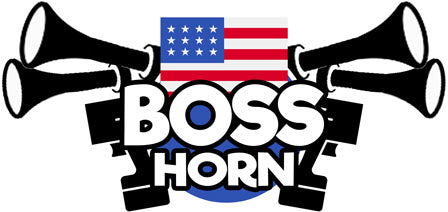
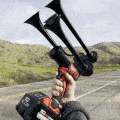
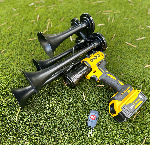
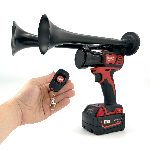
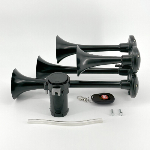






 https://bosshorn.com
https://bosshorn.com

























































